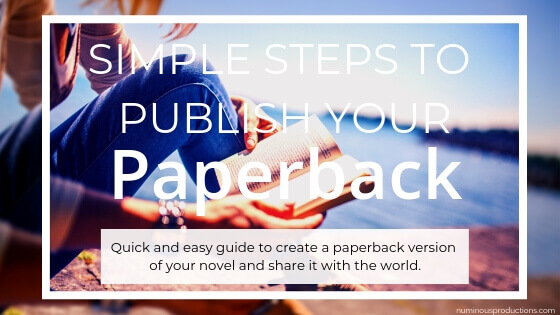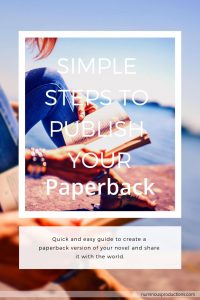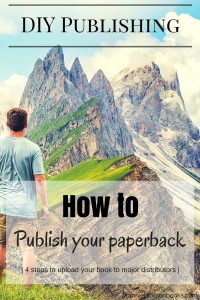The great thing about paperback publishing is, with the ability to make your book available to the major book distributors, the only difference between you and a traditional publisher is your level of professionalism.
While most authors who turn publisher are daunted by the idea of creating an ebook, I’m sorry to say that publishing a paperback is actually trickier. That being said, it’s totally possible and if you take the time to get the details right and you’ll have a beautiful, professional book in the end.
Details Matter
Before you begin working with your paperback you need to decide what trim size you want.
While this is primarily an aesthetic choice (how do you want your book to look on shevles?) it’s worth noting that a smaller trim size will result in high page count. This will impact your royalties since a higher page count costs more to create and therefore results in a decrease in per book royalty. It may not be a significant difference but it’s always good to be aware of the impact of your choices.
Once you select your trim size you’ll know what cover size you’re working with and how to format your book properly.
Formatting
While you have more interior design options with a paperback, you also have to be more exact with different elements.
Start with a copy of your formatted ebook doc. This your manuscript in its simplest form with minimal formatting. Then change the easy stuff–add images or flourishes to your chapter headings, embellish your styles (Heading 1, Sub-heading, etc) but still use styles for any formatting or text changes.
Then rearrange your front and back matter, if you’d like. For instance with an ebook you may want your copyright in the back but with a paperback you want it in the front. Also update your isbn, using a new number for the new foramt.
Next you need to add a bit of formatting that’s unnecessary for ebooks: Headers and Footers. The first step is to section off your book, probably into 3 sections.
At the end of all your Front Matter insert a break (Alt+I+B) but instead of inserting a page break, insert a section break.
Then at the end of your novel before any of your Back Matter, insert another section break.
A basic rule of thumb here is that the first and last section won’t have any page numbering, or will start/end with a different numbering sequence. The section in the middle is your narrative with standard page numbering.
Page Numbers
When you add your page numbers either to the Head or Foot of the middle section, there’s a little square that says “Link to Previous Section” which you want to uncheck. That way you have different Head and Foot rules for the different sections.
Titles and Bylines
Decide if you want your book title or your name to be included in the Head or Foot of the main section and add them accordingly. Probably you don’t want them in either the Front Matter or Back Matter.
Fonts and Headings
Since this is a paperback, you have actually have control over your fonts, as opposed to an ebook.
The first question with fonts is serif or san serif. The answer (spoiler alert) is serif.
This is a serif font (Georgia). Notice that letters have little accents hanging off the edges.
This is a sans serif font (Open Sans which is more of a web font than a book/print font). Notice how all the letters are straight and flat.
Most books are written with serif fonts. Sans Serif is used sparingly for text that needs to stand out or you want to have more stylized. Very few books are written entirely in sans serif (like maybe a sci-fi book or something going for ultra modern but some people think it gets wearing).
Good serif fonts (for the body of the book)
- Georgia – most common in fiction and good for both print and as a base in the ebook version. It’s subtle (so the reader focuses on the words and not the print) and it’s readable.
- Baskerville, often used in printed novels but not as good for digital
- Hoefler Text
- Sabon
- Garamond (not ITC Garamond) or Garamond premiere pro for fancy chapter headings
- Century (not Century Gothic)
- Minion Pro
- Times New Roman is not actually on the list except to suggest you not use it. Professionally designed print books don’t use Times New Roman.
Good sans serif fonts (used sparingly for contrast)
- Palatino
- Trade Gothic
- Franklin Gothic
- News Gothic
- Myriad
- Helvetica Neue
Chapter Formatting
The first paragraph of each chapter should already be full out (with no indent) from the ebook formatting. In print, the Normal indent is 2-3 characters (.2 or .3).
Chapter Headings can be more detailed in print. 18pt or 24pt. Centered and probably a different font than your body text. Add a space after the chapter heading (in the Heading 1 style, don’t use hard returns – a space of 42 pt is 3 lines, as a guide).
Margins
The final step in formatting is to set your page size and margins. I recommend downloading a template from Amazon based on your trim size and resulting page count. You need to go through a few steps in entering your book details before you get to the Print Book options. Once you get to the print book section and select your trim size, you can download the template that fits your trim size.
Based on the template, go to your paperback document in Word and go to Layout then Page Size (choose Whole document at the bottom of the pop up otherwise you have to do it three times for each section) and on the first tab (Margins) in the Pages section select Mirror margins. Then on the second tab (Paper) change the Width and Height to match your trim size.
Back on the Margins tab, you’ll also need to adjust the top, bottom, inside, outside and gutter margins based on the template. Start with: .76 / .76 top and bottom, .8 / .8 left and right and either .12 or .14 gutter. Once you think you’ve got it right, upload it to Kindle and go through the check looking for errors.
Odds are, even with the template, you’re going to have to tweak the margins again, and again, and again. Because each change in one of the margin settings shifts your page count which then changes the margin requirements so it’s not straight forward. It’s a matter of finding the perfect balance and the Amazon error checker helps tremendously even if it’s infuriating to have to go through again and again. And again.
After you finally get it exactly right, resize any images you have to fit within your margins.
Cover
You can download cover templates in Amazon with guides for where your front, spine and back should line up based on your trim size.
Start with a new image file (separate from your ebook cover).
- Add your base ebook image to the front. Then add the title and byline separately so you can resize and align each piece correctly.
- Add another copy of your title and byline and spin them 90 degrees for the spine. You may also want to include a logo for your publishing company or the company name as text.
- Use your your synopsis for the back cover. Or you may want to use a key quote along with blurbs from early reviews.
- If you’ve used any distinctive glyphs or themes on the front (which of course you kept as a separate layer or two), you’ll want those pieces for the back–both to connect the front and back and also to give the back a bit of style.
- Finally, you’ll probably want a base color picked from your cover that wraps across both the front and back. That way you can easily build different image pieces on top of it and still keep a unified look all around.
You might think the base color is a first step and not a last, but once you fill the whole template with that color, you won’t see the guide lines any longer so this is a good last step before you merge everything. (But also keep a layered copy, in case you need to make any adjustments or changes.)
Publishing your Paperback
Like ebook publishing, the first step is to enter basic information about your book–you’ll need your synopsis, author bio, ISBN and keywords for your novel.
Remember to use your company information for the email address, name, and the bank account you set up for direct deposit payments.
Then you’ll need to select the print details.
- Trim Size
- Interior Print color (either black and white or color)
- Paper color
A good combination is creme paper with b&w printing.
Then we start to get into some differences between the different print vendors.
There’s one key trick if you want to use both Amazon and Nook Press. Because if you choose Amazon’s Expanded Distribution your paperback will still be available at Barnes and Noble BUT you’ll get a reduced royalty and you won’t be able to publish it with Nook Press at that point because they already have your ISBN registered in their catalog. Yup, learned this the hard way.
So, publish with Amazon first but don’t select Expanded Distribution. Only make it available at Amazon. Then publish with Nook Press to make it available at Barnes & Noble. Then go back and select Amazon’s Expanded Distribution to make it widely available.
Amazon
You can upload your paperback document and paperback cover. Their preview will check for errors.
Except for having to make small tweaks to resolve the errors, uploading your files again and going through the whole process multiple times, it’s pretty easy.
Nook
You have to upload the file as a pdf (File then Export As will save your paperback document as a pdf).
Nook also has a preview and will highlight errors but if you’ve gone through everything with Amazon you’ve probably got it all sorted at this point.
Distribution
Then you get to determine the price for your book. Each distributor has a nice calculator to show what your royalties will be at different prices.
Once you’ve entered and uploaded everything you need, there’s a review that generally takes 24-48 hours. You’ll get an email informing you if your book is approved or if there are changes you need to make. If there are no errors, then it’s only a few more in order to make your book available.
Order and Review
Once it’s all said and done, you can order a copy of your book.
That way you can review it and make sure everything looks and feels the way you want.



